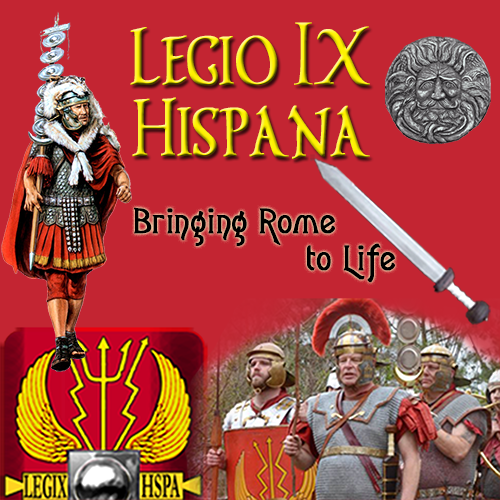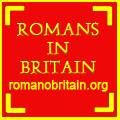Roman Messgear
- Aqua Vescae (canteen)
- Patera (messtin)
- Vas (cookpot)
- Poculum (cup)
- Conclear (Spoon)
- Eating Knife
Aqua Vescae (canteen)
(Gourd, Laguncula (Canteen) Or Vesica Aquae (Water Skin))


 "Canteen"... to us modern folk, a canteen is indispensable. However, no one knows what the miles carried his water in. We can guess, some believe it was a gourd (what is possibly depicted on Trajan's column), some a leather water-skin (like a “bota bag”) and others believe it might have been a metal or ceramic canteen, as some (but not many) have been found at Roman sites.
"Canteen"... to us modern folk, a canteen is indispensable. However, no one knows what the miles carried his water in. We can guess, some believe it was a gourd (what is possibly depicted on Trajan's column), some a leather water-skin (like a “bota bag”) and others believe it might have been a metal or ceramic canteen, as some (but not many) have been found at Roman sites.
Laguncula (metal or ceramic canteen)
Below left: Original metal canteen on left and on the right, another original from Nijmegen, Holland. This last, is the one "sort of" copied by Deepeeka and commonly carried by reenactors — although it is more likely, an oil container.

 Several iron flasks with bronze fittings have been found. At least one of which has a locking cap, while another has enamel decoration, so it is not certain that these were general-issue items. They seem to hold a quart or more, the example from Newstead measuring 5¾” in diameter by 4” wide. A number of ceramic flasks of similar shape and size have been found, which may have been canteens, though they generally seem to be rather thin and fragile for that. Some are cylindrical like the iron flasks, others are lens- shaped in section. A few have loops at the top for a cord, but otherwise could have been carried in the net bag. They are reddish or gray in color, and some are decorated with concentric rings, or rings of raised dots.
Several iron flasks with bronze fittings have been found. At least one of which has a locking cap, while another has enamel decoration, so it is not certain that these were general-issue items. They seem to hold a quart or more, the example from Newstead measuring 5¾” in diameter by 4” wide. A number of ceramic flasks of similar shape and size have been found, which may have been canteens, though they generally seem to be rather thin and fragile for that. Some are cylindrical like the iron flasks, others are lens- shaped in section. A few have loops at the top for a cord, but otherwise could have been carried in the net bag. They are reddish or gray in color, and some are decorated with concentric rings, or rings of raised dots.
Patera (mess pan or messkit)
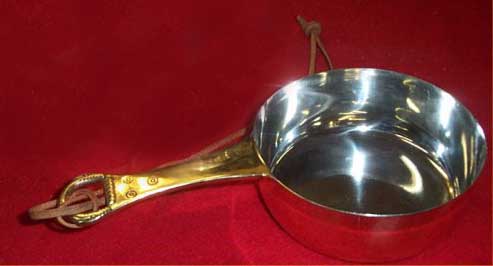 The patera is an all-purpose mess pan, for cooking, eating, and probably drinking. It was made of bronze
(brass may be used instead), and was apparently often spun from a blank which included
the
handle. Some examples do have handles added on in various ways, and some are hammered. The patera can be the
"simple" style with a flat bottom and fairly straight sides, or have base rings cut in on the
lathe, both to counterbalance the heavy handle and to distribute heat while cooking. Either type can be from
4" to 8" in diameter.
The patera is an all-purpose mess pan, for cooking, eating, and probably drinking. It was made of bronze
(brass may be used instead), and was apparently often spun from a blank which included
the
handle. Some examples do have handles added on in various ways, and some are hammered. The patera can be the
"simple" style with a flat bottom and fairly straight sides, or have base rings cut in on the
lathe, both to counterbalance the heavy handle and to distribute heat while cooking. Either type can be from
4" to 8" in diameter.
For years, there was little real choice for a patera and what there was was not good, unless you wished to pay a smith to do a custom job — think $$$. For awhile, you could get a great patera from Soul of the Warrior, but alas, it seems they no longer sell those and are back to the funky ones from the sub-continent.
Vas (cookpot)
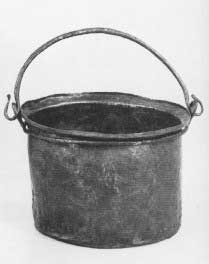 The vas (cook pot) or situla (bucket) came in
a
variety of shapes and sizes, about 5" to 8" in diameter by 7" to
10" tall. The handle could be attached by 2 riveted loops or by means of a heavy wire with loops in it
around the rim of the pot. The patera and the situla should be tin-lined. There are some repros, but as of
last report, Deepeeka's had too-high of a lead content to use for eating :-o If you look at photos and then
go to ebay, you can find many old copper and brass pots that are just like this that will
be usable with a good cleaning.
The vas (cook pot) or situla (bucket) came in
a
variety of shapes and sizes, about 5" to 8" in diameter by 7" to
10" tall. The handle could be attached by 2 riveted loops or by means of a heavy wire with loops in it
around the rim of the pot. The patera and the situla should be tin-lined. There are some repros, but as of
last report, Deepeeka's had too-high of a lead content to use for eating :-o If you look at photos and then
go to ebay, you can find many old copper and brass pots that are just like this that will
be usable with a good cleaning.
Right: An original bronze situla found in a well at Buch on the Rhine frontier.
(photo courtesy of our friend at Roman
Recruit
(a great website, be SURE to visit it!!!)
Poculum (cup)
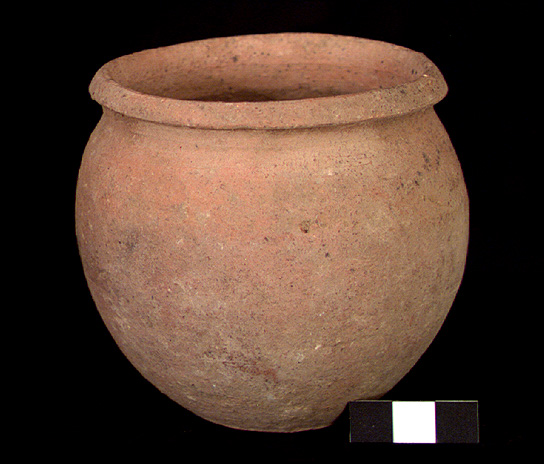 Simple cylindrical drinking cups are fairly common finds, perhaps
2½" in diameter by 4"
tall. Other types of cups based on original examples may also be used.
Left: Original cup.
Simple cylindrical drinking cups are fairly common finds, perhaps
2½" in diameter by 4"
tall. Other types of cups based on original examples may also be used.
Left: Original cup.
These days, the BEST place to get a cup from (along with ANY OTHER Roman pottery) is
Soul
of the Warrior! You CANNOT go wrong buying from Rusty — his stuff is well-tested
and a good price. Make
sure they have it in stock before you order!
Below are examples of cups with the unit name incised in the cup.
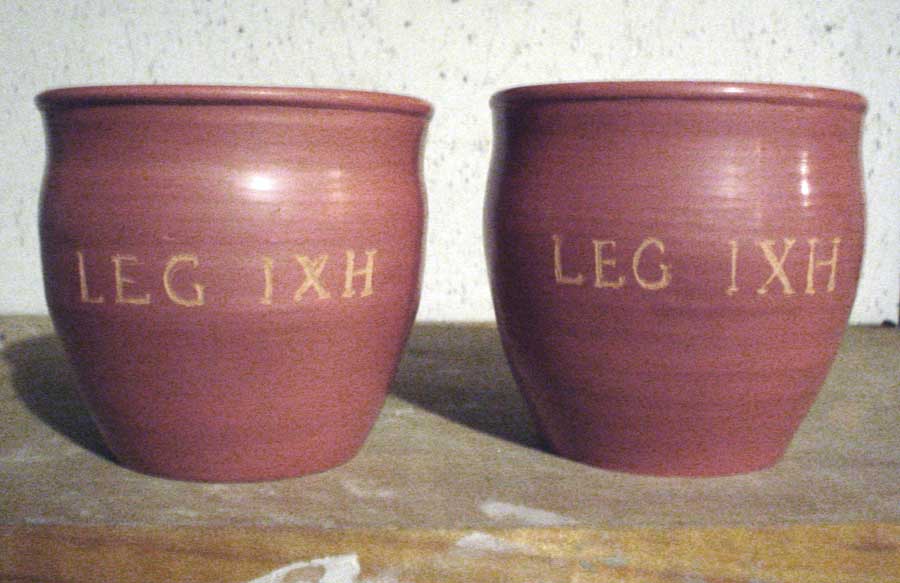
Eatin' Irons
A conclear (spoon) may be iron, bronze, wood, bone, or horn. A small knife is
useful, and can have a folding blade. Alas, Romans didn't have forks. Sorry… deal with it. Maybe they used chopsticks… Horn
spoons abound on the Internet; start here. Really, there are also a zillion on
etsy.com.
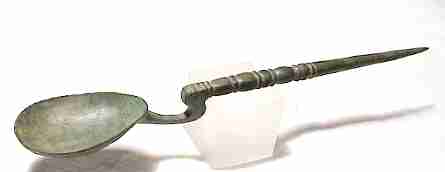

As far as a eating knife goes, Kult of Athena sells a AH3286 Roman Utility Knife is perfect and a great value. If this is too much like every one else, do a google search for "Roman utility knife" and resuilts will abound — just make sure it looks right. Roman small knives seem to mostly have the "kinked-looking" blade as seen in the photo here.


